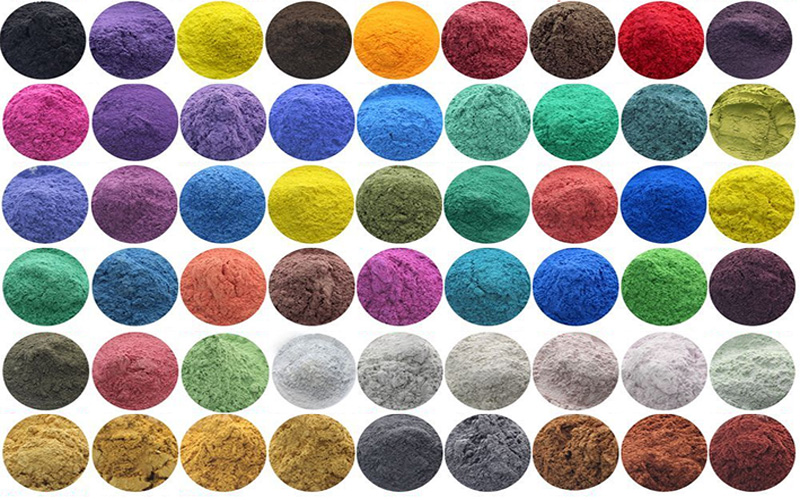The standard order for the ingredient declaration on a cosmetic product label is the “descending order of predominance” (most first, least last). There is an alternate order, which makes it easier, especially for color additives.
Ingredient Declaration – Alternate Order:
- Ingredients present at more than 1% in descending order of predominance.
- Ingredients present at 1% or less in any order.
- Color additives, regardless of amount, in any order.
When you use the alternate order, the color additives go at the end, regardless of the amount. Simple.
But what can be considered a color additive? And how should it be named?
Basics … What IS a Color Additive?
For the purpose of the ingredient declaration for cosmetics (as well as their formulation), the term “color additive” is defined in federal laws1 and regulations.2 In plain English:
COLOR ADDITIVE: A dye, pigment, or other substance that can change the color of a food, drug, cosmetic, or the human body (or any part of it), no matter how it’s made or from what source.
The key here is that it CAN change the color of the cosmetic or of the human body.
There is one exception…
EXCEPTION: If the substance is used for a purpose other than coloring
AND the color from the substance is clearly unimportant to the appearance, value, marketability or consumer acceptability of the final product.
The key here is that the color is CLEARLY UNIMPORTANT to the value of the product. If the substance meets this requirement, then it is not considered a color additive.
Allowed Color Additives
To be legally used in a cosmetic, a color additive must be:
- Approved by the FDA for use in cosmetics
- Meet any specifications set for the color (such as maximum lead levels, certification, etc.)
- Used only as allowed (generally, external use, eyes)
There are 36 dyes approved by the FDA. These are called “certified colors.” All manufactured batches of the dye must be tested by the FDA and certified that they meet the required standards. Interestingly, colors are the only substances that the FDA itself tests and certifies.
There are also 29 plant, mineral, or pigment based ingredients approved for use in cosmetics. They do not have to be tested and certified by the FDA, but they must still meet certain purity standards.
The entire list is published by the FDA: Color Additives Permitted for Use in Cosmetics
Correct Name to Use
The correct name to use in the ingredient declaration is the name the FDA uses in their list of color additives permitted for use in cosmetics. Where the color additive is a dye, you can leave off the “FD&C” or “D&C” and just list the color and number (e.g. “Green 6” or “Red 30”). Simple.
Gotchas and Special Cases
When it comes to color additives in the ingredient declaration (and in your formulation) there are a few special cases and potential “gotchas” you need to watch out and be prepared for:
Blended Color Additives
Many of the color additives you purchase for use in cosmetics or soap are actually blends of several color additives. For example, a “colored mica” is actual a blend of MICA with other color additives. Mica is basically transparent, so other color additives (usually ultramarines, iron oxides, titanium dioxide, or dyes) are used to give the final product color. Sometimes there are ingredients in the color blend that aren’t approved as color additives (usually tin oxide, tin dioxide, or some plastics).
RULE: With a blended color, put the approved color additives at the end of the ingredient declaration. Put the non-color additives before the color additives, in the correct order with the main ingredients present (probably in the 1% or less section).
Clays
Colored clays (e.g., French Green Clay, Rose Clay, Brazilian Purple Clay) are NOT APPROVED as color additives. However, some clays are enhanced with approved color additives to make the color more vibrant. Check with your supplier to verify if that is the case. (See Ingredient Declaration: Clays)
Note that since clays are not approved color additives, you cannot use them to change the color of a cosmetic (or a soap that is a cosmetic).
RULE: Put clays with the regular ingredients. If the clay has been enhanced, put the actual color additives at the end of the ingredient declarataion.
“May Contain” (Branded Shade Lines)
The FDA recognizes a special thing called a “branded shade line.” That’s a set of small cosmetic products (like eye shadows or lipsticks) that are all formulated and packaged identically… except for the color. In that case, you can use the same label for all the products, with the phrase “May Contain” to identify the color additives that are in one or some of the products, but not all.3
RULE: In labeling a branded shade line, create one label for all products. List the color additives that are in ALL of the products, and then list the color additives that are in one or more products, prefaced by “May contain:”
Glitter
Technically, the FDA says that glitter is not an approved color additive because it is made up of colors bonded onto a non-color surface (most typically PET plastic). However, the use of glitter in cosmetics is widespread and the FDA doesn’t seem to be enforcing color additive regulations on glitter-containing products.4
However, glitter has come under increased scrutiny lately because these small plastic particles end up as microplastics in the ecosystem. The EU has already passed a ban on glitter in cosmetic products unless it is water-soluble or biodegradable, or larger than 5 mm. The ban is currently in the implementation stage: glitter in rinse-off products goes into effect October 17, 2027, for leave-on cosmetics October 17, 2029, and for make-up, lip, and nail products October 17, 2035.
RULE: Check the actual components used to make the glitter. List color additives with the color additives at the end of the ingredient declaration, and any non-color additives with the regular ingredient.
Natural Colorants
The term natural colorants is often used to describe plant-based substances that are used to color soap, such as madder root, alkanet, nettle, sage, paprika, and turmeric. The catch here is that while they do change the color (and so are color additives), they are not approved as color additives for use in cosmetics.
RULE: Don’t use “natural colorants” to color cosmetic products, including soap that is a cosmetic.
Soap That is NOT a Cosmetic
Soap is applied to the human body to cleanse (the definition of a cosmetic), but it isn’t ALWAYS a cosmetic. There’s an exemption.5
IF the soap is:
- The alkali salt of fatty acids (made by combining lye, water and oils/fats/butters; AND
- It is only labeled and marketed as “SOAP” AND
- It only claims to clean AND
- No other claims — such as moisturizing or exfoliating — are made for it
Then it is exempt from the definition of a cosmetic. In other words, it is NOT a cosmetic, it is a basic household product (like dish soap or toilet paper). That means that the cosmetic regulations don’t apply – including the rules for the ingredient declaration and any limitations on what you can use to color your soap. (Of course, the safety of the soap still applies – don’t use colorants that are not safe for human contact!)
Note that detergent-based soap is ALWAYS a cosmetic (even if it is called “soap” and no other claims are made. That’s because it is NOT the alkali salt of fatty acids.
RULE: If your intention is to treat your soap as a household product (keeping it exempt from the definition of a cosmetic) do not put any cosmetic-type claims about the soap on the label or in any of your marketing materials (including website copy and social media posts about the product).
- 21 USC 321(t) ↩︎
- 21 CFR 70.3 ↩︎
- 21 CFR 701.3(g) ↩︎
- The 2016 edition of the FDA’s Compliance Program Guidance Manual included this statement: “At this time, FDA is developing an enforcement strategy for cosmetic containing glitters and micas-based pearlescent pigments.” That statement was not included in the 2023 edition of the Guidance Manual, but no additional details on their “enforcement strategy” have been issued. ↩︎
- 21 CFR 701.20(a) ↩︎


Leave a Reply